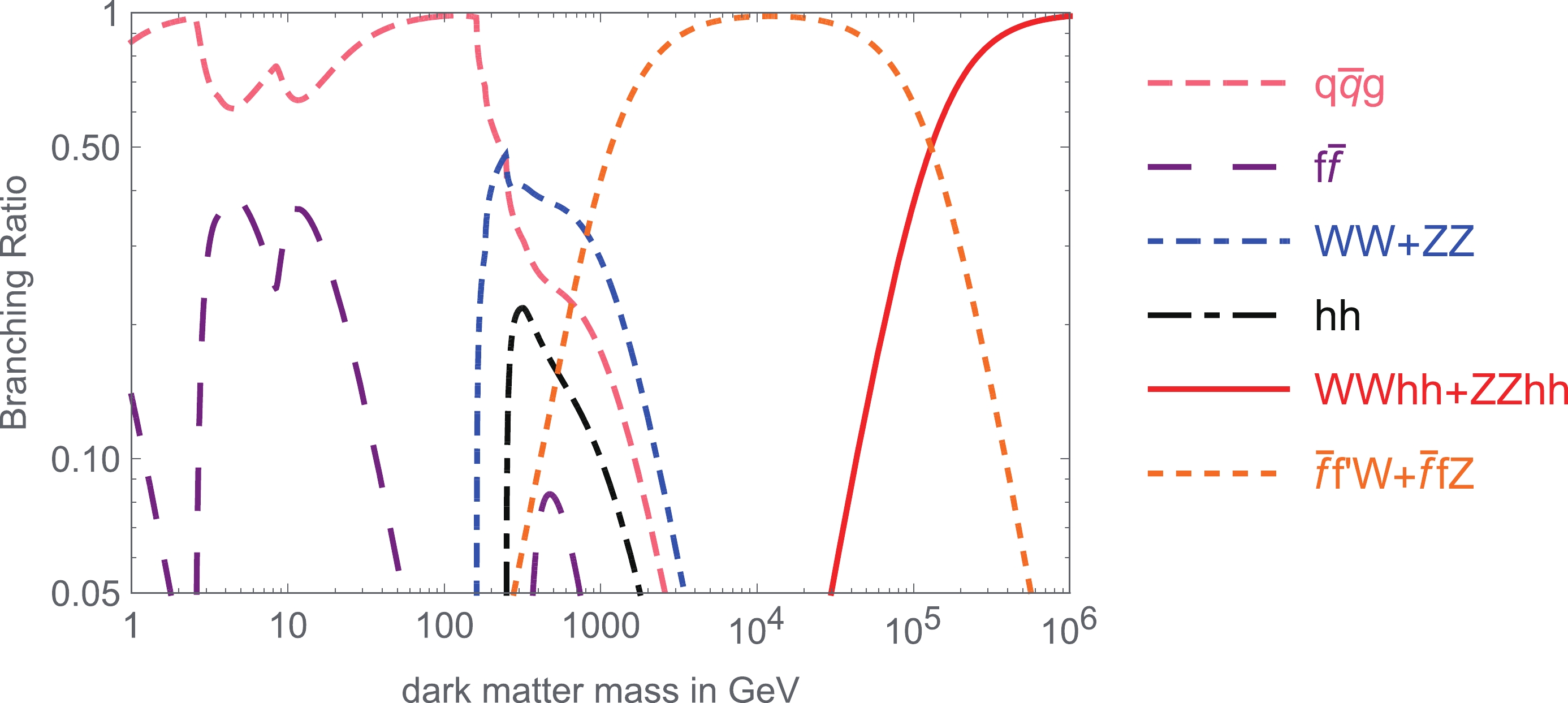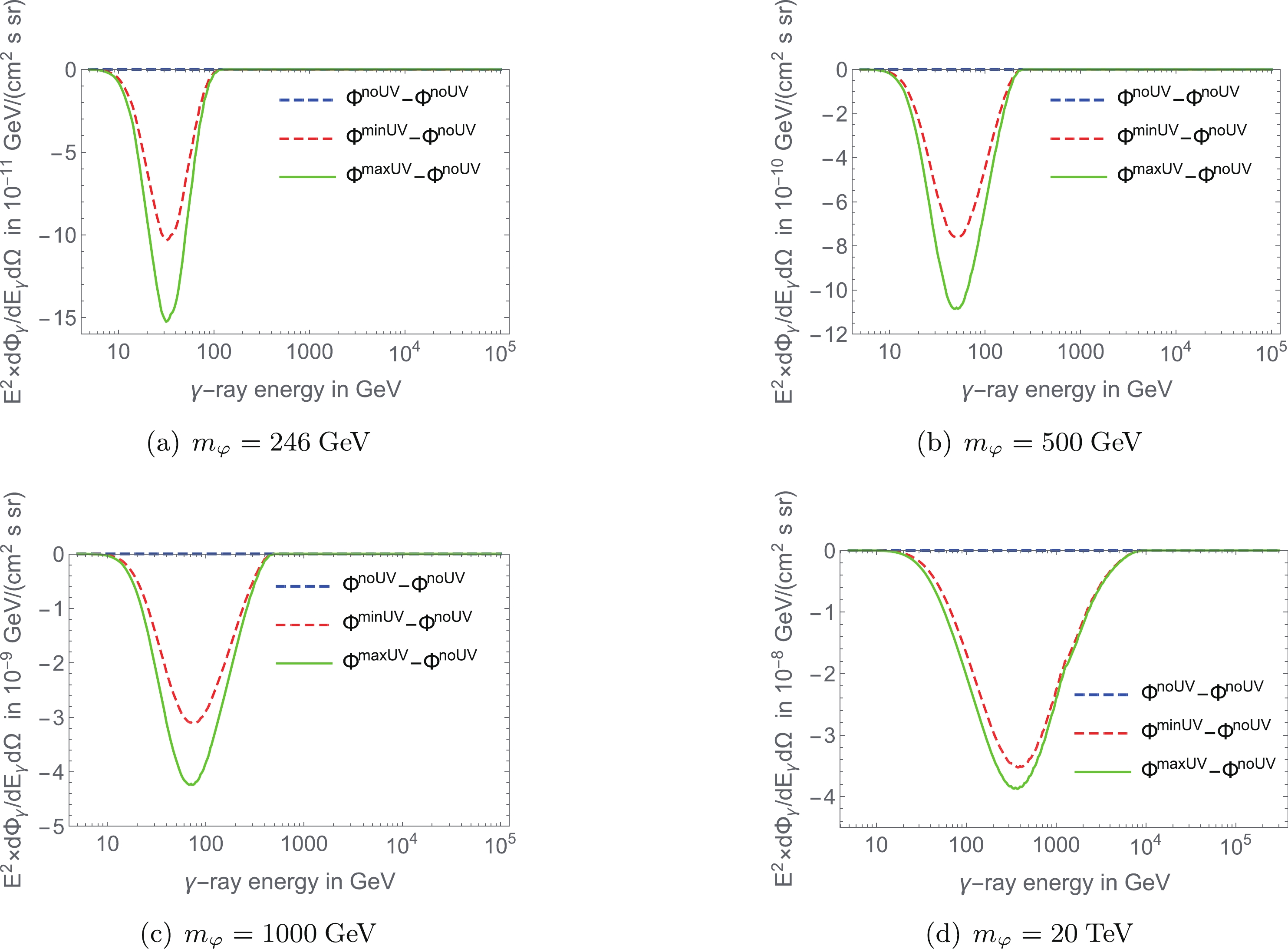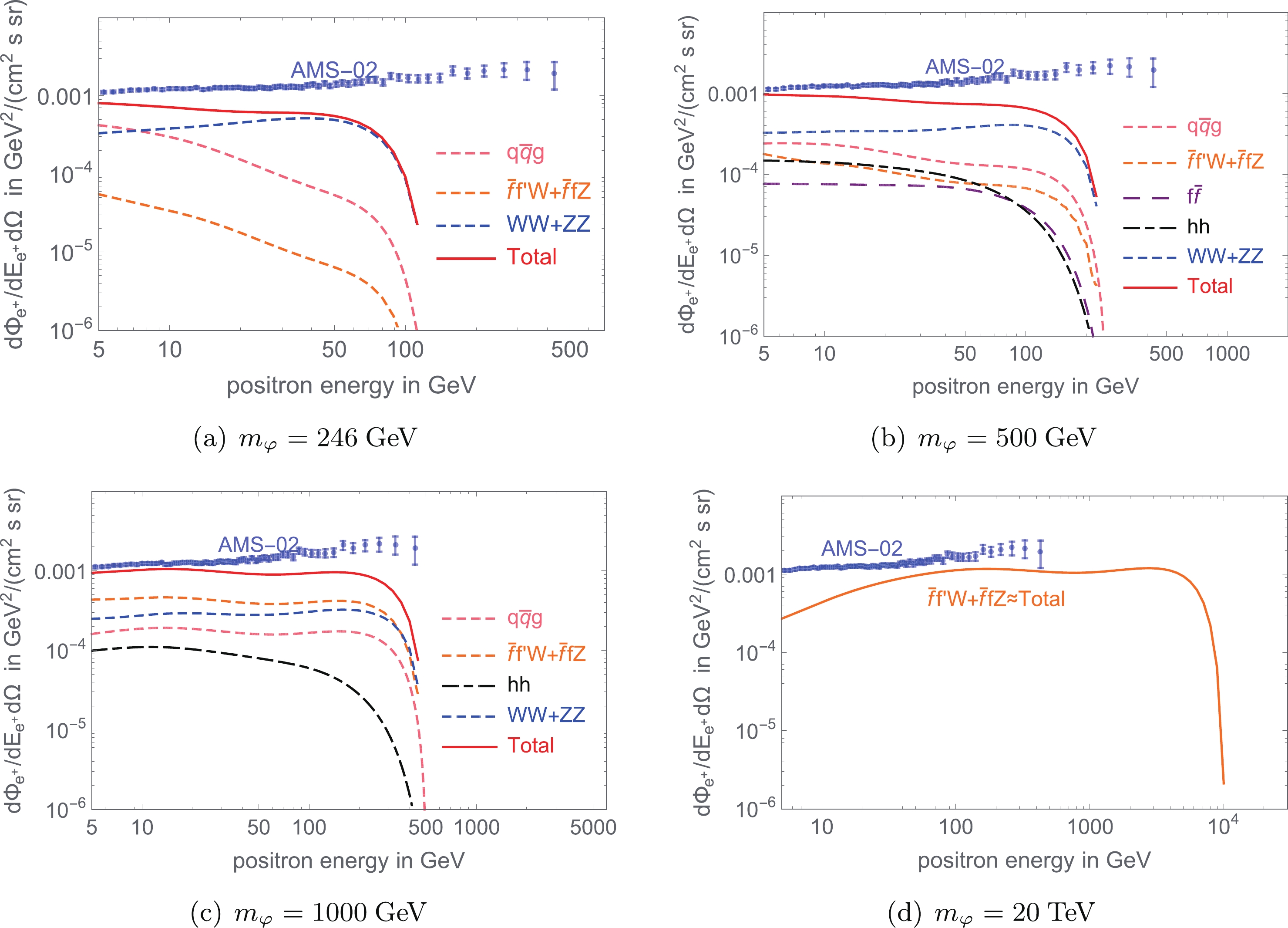HTML
--> --> -->Among the various properties of DMps, we are concerned with their stability because if DMps are unstable, their decay products can be observed with satellites [5-7]. The stability of electrons is guaranteed by electric charge conservation, whereas the stability of neutrinos is guaranteed by Lorentz symmetry. Recent observations suggest that DM is stable and may be composed of particles. Typically, DMps are assumed to have global symmetry in Minkowski space-time, such as the hypothetical
O. Catà et al. [16, 17] have proposed models to describe how global symmetry breaking of scalar singlet dark matter (ssDM), inert doublet DM, and fermionic DM can be induced by nonminimal coupling with gravity. There have been other attempts to study the nonminimal coupling regime. For example, the Higgs field may have nonminimal coupling with gravity in Higgs inflation [18]. If the mass of a dark matter particle (DMp) is less than 270 MeV, then that particle could be acting concurrently as an inflaton [19]. There are also models of nonminimal coupling between DM and gravity where the global symmetry is not broken [20-22]. The nonminimal coupling between complex scalar DM and gravity has also been used to explain both the inflation and the electroweak phase transition [23, 24].
Many observations and experiments are needed to define the constraints on the global symmetry breaking of DMps. Currently, many types of experiments and observational methods are being used to search for DMps. Direct detection methods rely on monitoring the nucleon recoil induced by interactions with DMps distributed around the Earth [25]. Indirect detection methods search for photons, neutrinos, and/or cosmic rays produced by DMps using satellites and Earth-based instrumentation [26]. The Large Hadron Collider serves as a complementary experiment in the search for DM. Cosmological studies have defined constraints on DM. If nonminimal coupling with gravity breaks the global symmetry of DMps, then DM would be unstable. Consequently, DM would decay into observable particles such as cosmic rays [27], neutrinos [28], or cosmic gamma-rays [29]. Current observational techniques are still useful for defining the constraints on the stability of DMps, even though no conclusive particle signal has yet been attributed to DM [30].
O. Catà et al. [31] used chiral perturbation theory to determine the allowed parameter space of light ssDM particles (i.e., less massive than 1 GeV), in which the decay products have a sharp photon spectrum. These authors obtained the strongest constraints to date using Fermi-LAT gamma-ray observations. However, the mass of weakly interacting massive particles (WIMPs) and super WIMPs, based on the gauge hierarchy problem, and hidden DM, based on the gauge hierarchy problem and new flavor physics, is expected to be in the GeV–TeV range [32]. If the mass of a DMp is in the GeV–TeV range, more decay channels will be opened, and the decay properties of DMps will be quite diverse. Assuming that the lifetime of DMps is longer than the age of the universe and using observation data from neutrino telescopes, O. Catà et al. [16, 17] proposed rough restrictions on the nonminimal coupling coefficients between several widely studied DM candidates and the Ricci scalar in the GeV–TeV range.
In the case of DM decay, constraints obtained via indirect-detection methods play an important role. For example, satellites such as Fermi-LAT [33], Alpha Magnetic Spectrometer (AMS) [34], and DArk Matter Particle Explorer (DAMPE) [35] can obtain sensitive observations of high-energy photons and cosmic rays. In this work, we consider only the positron data obtained by AMS-02 [34] and photon data obtained by Fermi-LAT [33] to reveal conservative indirect restrictions of the GeV–TeV range because DAMPE is unable to distinguish positrons from electrons.
The action is constructed in the Jordan frame, according to the work of O. Catà et al. [17]. One can choose to calculate the specific decay channel in either the Jordan frame or Einstein frame when using Feynman diagrams. For example, J. Ren et al. [36] used the quantum field theory method to calculate Higgs inflation in Jordan and Einstein frames. They obtained the same result with both frames, indicating that the the Jordan and Einstein frames are equivalent in these scenarios. Then, in the Einstein frame, we calculate the spectra of photons and positrons arising from the decay of ssDM particles in the GeV–TeV range, where WIMPs, super WIMPs, and hidden DM mass are likely to be. Finally, we obtain constraints on the lifetime and the nonminimal coupling constant
The structure of this paper is as follows. In Section 2, we introduce the model and discuss the decay branch ratio of ssDM around the electroweak scale. In Section 3, we describe the calculation of the ssDM decay spectrum induced by global symmetry breaking. In Section 4, we explain the statistical methods used to compare the expected spectrum from decaying ssDM with the observed spectrum from Fermi-LAT and AMS-02. In Section 5, we provide the decay spectra of ssDM induced by global symmetry breaking and a reasonable parameter space for the lifetime of ssDM and the nonminimal coupling constant. The discussion and conclusions are presented in Section 6.
2.1.The model
O. Catà et al. [16] considered that DM can nonminimally couple with the Ricci scalar, whose global symmetry is broken in curved space-time. In this paper, we focus on ssDM. In the Jordan Frame, the action $ {\cal{S}} = \int {\rm d}^4x \sqrt{-g} \left[-\frac{R}{2\kappa^2}+{\cal{L}}_{\rm SM}+{\cal{L}}_{\rm DM} -\xi M \varphi R \right], $  | (1) |
The Einstein–Hilbert Lagrangian
$ {\cal{L}}_{\rm SM} = {\cal{T}}_F+{\cal{T}}_f+{\cal{T}}_H+{\cal{L}}_Y-{\cal{V}}_H , $  | (2) |
$ {\cal{T}}_F = -\frac{1}{4}g^{\mu\nu}g^{\lambda\rho}F^a_{\mu\lambda}F^a_{\nu\rho}, $  | (3) |
$ {\cal{T}}_{f} = \frac{i}{2} \bar{f} \stackrel{\leftrightarrow}{\not\!{\nabla}} f, $  | (4) |
$ {\cal{T}}_H = g^{\mu\nu}(D_\mu \phi)^\dagger (D_\nu \phi). $  | (5) |
In Eq. (1),
The research content of this paper comes from the last term of Eq. (1). Specifically,
Using conformal transformation,
$ \tilde{g}_{\mu\nu} = \Omega^2 g_{\mu\nu}, $  | (6) |
$ {\cal{S}} = \int {\rm d}^4x \sqrt{-\tilde{g}} \bigg[ -\frac{\tilde{R}}{2\kappa^2} +\frac{3}{\kappa^2} \frac{\Omega_{,\rho}\tilde{\Omega}^{,\rho}}{\Omega^2} +\tilde{{\cal{L}}}_{\rm SM}+\tilde{{\cal{L}}}_{\rm DM}\bigg], $  | (7) |
$ \tilde{{\cal{L}}}_{\rm SM} = \tilde{{\cal{T}}}_F+\Omega^{-3}\tilde{{\cal{T}}}_f+\Omega^{-2} \tilde{{\cal{T}}}_H+\Omega^{-4}({\cal{L}}_Y-{\cal{V}}_H), $  | (8) |
Eq. (8) indicates that DM
$ \tilde{{\cal{L}}}_{\rm SM,\varphi} = -2\kappa\xi \varphi \bigg[\frac{3}{2}\tilde{{\cal{T}}}_f + \tilde{{\cal{T}}}_H +2({\cal{L}}_Y-{\cal{V}}_H)\bigg]. $  | (9) |
terms from   | physical process | Feynman rules |
  |   |   |
  |   |   |
  |   |   |
  |   |   |
  |   |   |
  |   |   |
  |   |   |
  |   |   |
  |   |   |
In the table,                           | ||
Table1.Feynman rules for DM decay.
2
2.2.Branch ratio
The decay branch ratios of ssDM were drawn according to O. Catà et al. [16] and are shown in Fig. 1. O. Catà et al. also provided the asymptotic dependence of the corresponding partial width on the ssDM mass, using the limit of the massless final-state standard model particles, as shown in Table 2. This work focuses on the ssDM whose mass is around the electroweak scale. Figure1. (color online) Decay branch ratios of ssDM via non-minimal coupling with gravity.
Figure1. (color online) Decay branch ratios of ssDM via non-minimal coupling with gravity.| Decay mode | Asymptotic scaling |
  |   |
  |   |
  |   |
  |   |
  |   |
  |   |
  |   |
  |   |
  |   |
Table2.Tree-level decay modes of ssDM [16].
Below the electroweak scale (
Above the electroweak scale (
Around the electroweak scale (
Only the channels shown in Fig. 1 were included in the following numerical calculations.
3.1.Decay spectrum at production
Tanabashi et al. (Particle Data Group) [37] provided a detailed procedure to calculate decay rates and decay spectrum at production. These authors gave expressions for differential decay rates, e.g. Eq. (10), relativistically invariant three-body phase space, e.g. Eq. (11), and relativistically invariant four-body phase space, e.g. Eq. (14).For convenience, we indicate the three product particles arising from three-body decay as particle 1, particle 2, and particle 3. The nomenclature used to indicate the rest frame of particle i and particle j is
The expression of the differential decay rate is
$ {\rm d}\Gamma = \frac{1}{2m_\varphi}|{\cal{M}}|^2 {\rm d}\Phi^{(n)}(m_\varphi;p_1,...,p_n), $  | (10) |
$ {\rm d}\Phi^{(3)} = \frac{1}{2\pi} {\rm d}m_{12}^2 \frac{1}{16\pi^2} \frac{|\vec{p}_1^*|}{m_{12}}{\rm d}\Omega_{1}^* \frac{1}{16\pi^2} \frac{|\vec{p}_3|}{m_\varphi}{\rm d}\Omega_{3}, $  | (11) |
The relationship between
$ E_3 = \frac{m_{\varphi}^2+m_{3}^2-m_{12}^2}{2m_{\varphi}}, $  | (12) |
$ \frac{{\rm d}{N}^l}{{\rm d}E_3} = \frac{\partial\Gamma^l}{\Gamma^l \partial E_3}. $  | (13) |
There are three channels for the four-body decay:
The element of four-body phase space
$\begin{aligned}[b] {\rm d}\Phi^{(4)} =& \frac{1}{2\pi} {\rm d}m_{12}^2 \frac{1}{2\pi} {\rm d}m_{34}^2 \frac{1}{16\pi^2} \frac{|\vec{p}_1^*|}{m_{12}}{\rm d}\Omega_{1}^* \frac{1}{16\pi^2} \frac{|\vec{p}_3^{**}|}{m_{34}}\\&\times {\rm d}\Omega_{3}^{**} \frac{1}{16\pi^2} \frac{|\vec{p}_{12}|}{m_\varphi}{\rm d}\Omega_{12},\end{aligned} $  | (14) |
$ g(E_1,m_{12}) = \frac{1}{2}\frac{1}{\gamma_{12}\beta_{12}|\vec{p}_1^*|} \Theta(E_1-E_-) \Theta(E_+-E_1), $  | (15) |
The energy spectrum of particle 1 produced per decay in the channel with final state l can be described by
$ \frac{{\rm d}{N}^l}{{\rm d}E_1} = \int\int g(E_1,m_{12}) \frac{\partial^2{N}^l}{\partial m_{12}\partial m_{34}} {\rm d}m_{12}{\rm d}m_{34}. $  | (16) |
Spectra have been obtained for many stable and unstable particles, such as the Higgs boson, Z boson, and neutrino. However, the spectra of final–state stable particles (i.e., photons and positrons) also need to be calculated for comparisons with observations. Cirelli et al. [38] used the PYTHIA codes to generate spectra of photons and positrons
$ \frac{{\rm d}{N}^l}{{\rm d}E_{\gamma,e^+}} = \sum\limits_s \int k(E_s,E_{\gamma,e^+}) \frac{{\rm d}{N}^l}{{\rm d}E_s} {\rm d}E_s , $  | (17) |
2
3.2.Fluxes after propagation
The spectra that can be detected by satellites are calculated via PPPC 4 DM ID [38]. In the following, we uniformly adopt the Navarro-Frenk-White (NFW) DM distribution model: $ \rho(r) = \rho_s\frac{r_s}{r}\left(1+\frac{r}{r_s}\right)^{-2}, $  | (18) |
The differential flux of positrons in space
$ \frac{\partial f}{\partial t}-\triangledown({\cal{K}}(E_{e^+},\vec{x})\triangledown f)-\frac{\partial}{\partial E_{e^+}}(b(E_{e^+},\vec{x})f) = Q(E_{e^+},\vec{x}) , $  | (19) |
$ Q = \frac{\rho(r)}{m_\varphi}\sum\limits_l \Gamma_l \frac{{\rm d}N_{e^+}^l}{{\rm d}E_{e^+}}. $  | (20) |
$ \begin{aligned}[b] \frac{{\rm d}\Phi_{e^+}}{{\rm d}E_{e^+}}(E_{e^+},r_\odot) =& \frac{v_{e^+}}{4\pi b(E_{e^+},r_\odot)} \frac{\rho_\odot}{m_\varphi} \sum\limits_l \Gamma_l \int_{E_{e^+}}^{m_\varphi/2} {\rm d}E_s \frac{{\rm d}N^l_{e^+}}{{\rm d}E_{e^+}} \\ &\times(E_s) I(E_{e^+},E_s,r_\odot), \end{aligned} ,$  | (21) |
The calculation of gamma rays consists of three parts: the direct ("prompt") decay from the Milky Way halo, extragalactic gamma rays emitted by DM decay, and gamma rays from inverse Compton scattering (ICS). Synchrotron radiation is prevalent where the magnetic field and DM are very dense, near the galactic center. This work focuses on a high galactic latitude (
The differential flux of photons from the prompt decay of the Milky Way halo is calculated via
$ \frac{{\rm d}\Phi_\gamma}{{\rm d}E_\gamma {\rm d}\Omega} = \frac{r_\odot \rho_\odot}{4\pi m_\varphi} \bar{J} \sum\limits_l \Gamma_l \frac{{\rm d}N^l_\gamma}{{\rm d}E_\gamma} , $  | (22) |
The extragalactic gamma rays received at a point with redshift z are calculated via [38]
$\begin{aligned}[b] \frac{{\rm d}\Phi_{{\rm{EG}}\gamma}}{{\rm d}E_\gamma}(E_\gamma,z) =& \frac{c}{E_\gamma}\int_{z}^{\infty} {\rm d}z' \frac{1}{H(z')(1+z')}\left(\frac{1+z}{1+z'}\right)^3 \\&\times\frac{1}{4 \pi} \frac{\bar{\rho}(z')}{m_\varphi}\sum\limits_l \Gamma_l \frac{{\rm d}N^l_\gamma}{{\rm d}E_\gamma'}(E_\gamma') {\rm e}^{-\tau(E_\gamma',z,z')}, \end{aligned}$  | (23) |
Galactic electrons/positrons generated by ssDM could convert their energy into photons by inverse Compton scattering. The greater the mass of the ssDM, the higher the energy of the electrons/positrons generated by the ssDM, and the more important the effect. Inverse Compton gamma rays are calculated as follows:
$ \frac{{\rm d}\Phi_{{\rm{IC}}\gamma}}{{\rm d}E_\gamma {\rm d}\Omega} = \frac{1}{E_\gamma^2}\frac{r_\odot}{4\pi}\frac{\rho_\odot}{m_\varphi} \int_{m_e}^{m_\varphi/2} \!\!{\rm d}E_s \sum\limits_i \Gamma_i \frac{{\rm d}N_{e^+}^i}{{\rm d}E}(E_s) I_{{\rm{IC}}}(E_\gamma,E_s,b,l), $  | (24) |
4.1.Statistical methods used to define constraints
The IGRB is measured using Fermi-LAT data [33]. We compared theThe cosmic positron flux is measured by the AMS on the International Space Station [34]. We also compared the positron flux produced by DM with the measured flux to define constraints on the lifetime of ssDM.
The comparison strategies used in this paper are as follows. Define
$ \chi^2 = \sum\limits_i \frac{(\Phi^{\rm{th}}_i-\Phi^{\rm{obs}}_i)^2}{\delta_i^2} \Theta(\Phi^{\rm{th}}_i-\Phi^{\rm{obs}}_i), $  | (25) |
2
4.2.Treatment of the background
Unresolved sources, such as non-blazar active galactic nuclei, the unresolved star-forming galaxies, BL Lacertae objects, flat-spectrum radio quasar blazars, and electromagnetic cascades generated through ultra-high energy cosmic-ray propagation, can contribute to the IGRB. When the IGRB is used to constrain the lifetime of DM, some studies consider the contribution of these sources to obtain the most stringent constraints [42]. Other studies do not consider the contribution of these sources to obtain conservative constraints [41]. In this study, we do not consider unresolved source contributions to the IGRB; therefore, the results we obtain are conservative.The cosmic positron spectrum is believed to have a power-law background. We do not consider this contribution in the total predicted flux; therefore, the results obtained using the cosmic positron flux are also conservative.
Figure 2 shows the average photon flux values (
 Figure2. (color online) Average photon flux values (
Figure2. (color online) Average photon flux values (Figure 3 shows the average photon flux values (
 Figure3. (color online) Average photon flux values (
Figure3. (color online) Average photon flux values (Figure 4 shows the absorption of UV photons in the presence of the UV background compared with no UV background when
 Figure4. (color online) The presence of UV background lowers the UV photon density. The figure shows the absorption of UV photons compared with no UV background for
Figure4. (color online) The presence of UV background lowers the UV photon density. The figure shows the absorption of UV photons compared with no UV background forFigure 5 shows the positron flux from decaying DMps contributed by various channels when
 Figure5. (color online) Predicted positron flux from decaying DMps contributed by the indicated channels are shown for
Figure5. (color online) Predicted positron flux from decaying DMps contributed by the indicated channels are shown for The excluded two-dimensional parameter space (
 Figure6. (color online) The
Figure6. (color online) The  Figure7. (color online) The
Figure7. (color online) The In this study, we set constraints on the lifetime and the strength of symmetry breaking of ssDM particles using the most sensitive observations of photons and cosmic rays, respectively, made by Fermi-LAT and AMS-02. The data in Fig. 7 show that the non–minimal coupling constant between the Ricci scalar and ssDM is more constrained from indirect detection when the mass of ssDM is larger. This behavior is attributed to the fact that an ssDM particle with a larger mass has more decay channels and a larger phase space. This behavior also confirms the conclusion of O. Catà et al. that the exclusion of large regions of the parameter spaces in the GeV–TeV range requires additional stabilizing symmetry.
In contrast to previous work by [31], the masses of the ssDM particles considered in our study are around the GeV–TeV range. The decay channels around the GeV–TeV range are abundant, and the phase space is large. O. Catà et al. [31] showed that the lifetime of an ssDM candidate with a mass of approximately
A new paper on this topic [43], being written in parallel with this work, points out that the fermionic fields should be conformally rescaled in the Einstein frame. In their study, all the vertices containing only one gauge boson disappear. Meanwhile, the decay rate of all other channels, including the
Numerous theoretical and experimental works are in progress regarding the indirect detection of DM in the galactic region and beyond. On the theoretical side, S. Amoroso et al. [45] have produced spectra within PYTHIA 8.2 (which can be considered as updates to the PPPC 4 DM tables) following several improvements to the tuning of the PYTHIA 8 event generator and the perturbative machinery. Moreover, they estimated QCD uncertainties on particle spectra from showering and hadronization for the first time, which could prove useful for global fits. On the experimental side, the DAMPE detector was designed to run for at least three years, and the energies measured may reach 10 TeV [35]. The Large High Altitude Air Shower Observatory (LHAASO) can detect


